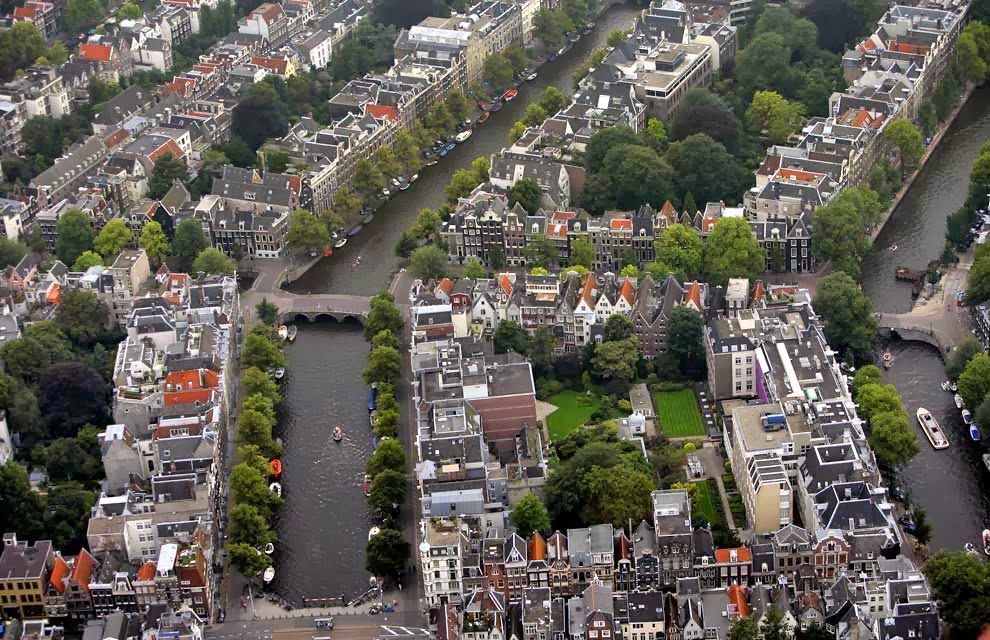 Rotterdam, The Netherlands, Europe's busiest port
Rotterdam, The Netherlands, Europe's busiest port
The Netherlands lies at the core of European trade and transport. Today 50% of goods entering the EU--the world's largest market--come through the Netherlands. One geographer calls the Netherlands "Europe's warehouse." Rotterdam is Europe's largest port by far, recently becoming the first European port to
handle 1 million shipping containers in one month. Meanwhile, Amsterdam is the world's #1 internet hub
With roughly the same area as Maryland, the Netherlands is relatively small country with a human geography built for movement of goods and people:
-the world's busiest rail network
-Europe's densest network of inland waterways (canals and rivers)
-Europe's 2nd-densest road network (motorways) behind neighbor Belgium
-the world's highest bicycle use (27% of all trips) and most bike-friendly country
-world's highest rate of electric care use and a
currently installing the world's largest network of electric vehicle (EV) fast-charging stations
Transshipment hub: from maritime to land
Freight arriving by sea at the port of Rotterdam is transferred at boggling speeds from ship to one of many other transport modes: rail, truck, river barge. In this way, the Netherlands is a "maritime / land interface." Meanwhile, thousands of containers belonging to international corporations are stored in the seemingly-endless array of warehouses in the Netherlands.
Location: at the core of the core or Europe
The Netherlands is situated at the crossroads of Europe's top three economies today: Germany, the UK, and France. The Netherlands' coastal border lies on the English Channel across from London. To south close by is Germany's largest urban agglomeration the
Ruhr along the Rhine river, which connects along the Rhine-Main-Danube canal all the way to the Black sea.
The roots of Dutch transport and tradeThe Netherlands' role as a trade and transport hub of Europe is nothing new: it has been at the center of European trade for centuries. Amsterdam's "spider web of canals and bridges" dates back to the Dutch Golden Age of the 1600s.
 Source: Hello Magazine from Amsterdam Tourism and Convention Board
Source: Hello Magazine from Amsterdam Tourism and Convention Board
Amsterdam in 1600 was the financial center of Europe and site of the world's first stock market the Amsterdam Stock Exchange founded in 1609.
But Dutch trade extended far beyond Europe's borders. In 1601 Dutch merchants formed the world's oldest public company, the Dutch East India Company, which would soon establish a Dutch Empire including the Spice Islands in what is now Indonesia; South Africa the world's gold and diamond capital; and a monopoly on trade with Japan which gave them silver.

On this map of population density in 1600 you can see The Netherlands was already covered in high-density populations. Also notably Ireland has more area with the highest population density than England does in 1600--which is illustrates just how remarble it was that Ireland would go on to lose half its population to famine and emigration during the famine years alone.
The Netherlands lies in the core of Europe's densest railway regions.
Rhine-Main-Danube Canal from Rotterdam to the Black Sea
Goods arriving in Rotterdam can follow the Rhine-Main-Danube Canal to 15 countries all the to the Black Sea--which then connects to Russia, Turkey, and Central Asia.
See
Amsterdam: A history of the world's most liberal cityand
The Island at the Center of the World
both by Russel Shorto (who also wrote a great NY Times article
"No Babies?")






